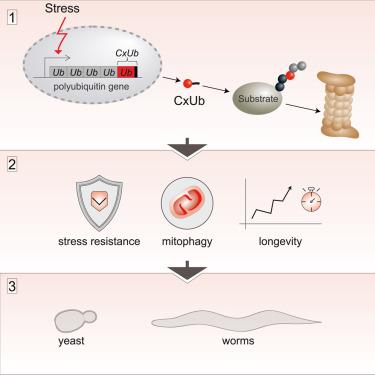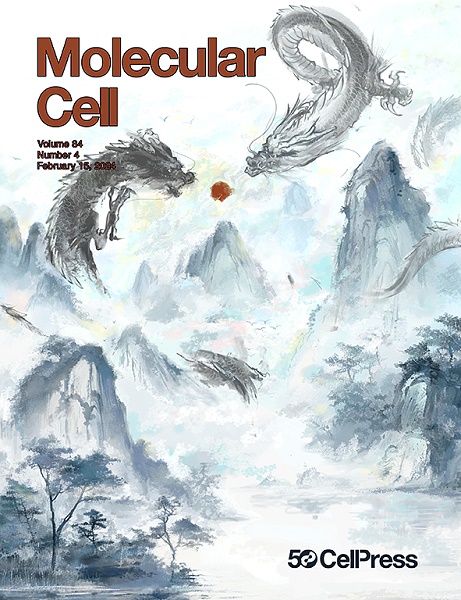Ubiquitin precursor with C-terminal extension promotes proteostasis and longevity
IF 16.6
1区 生物学
Q1 BIOCHEMISTRY & MOLECULAR BIOLOGY
引用次数: 0
Abstract
Ubiquitin is a conserved modifier regulating the stability and function of numerous target proteins. In all eukaryotes, polyubiquitin precursors are generated and processed into ubiquitin monomers. The final ubiquitin unit always contains a C-terminal extension, but its physiological significance is unknown. Here, we show that C-terminally extended ubiquitin, termed CxUb, is essential for stress resistance, mitophagy, and longevity in Saccharomyces cerevisiae and Caenorhabditis elegans. CxUb forms ubiquitin chains and binds to a previously undescribed region within the ubiquitin chain-elongating E4 enzyme Ufd2, which also functions during stress and aging. Ufd2 recognizes CxUb and conjugates it to substrate proteins, triggering their degradation. By contrast, CxUb is not required for basal housekeeping functions of the ubiquitin-proteasome system. These data suggest that the CxUb encodes a functionally unique ubiquitin form, specialized for proteostasis defects, expanding the code of post-translational modification processes.

具有c端延伸的泛素前体促进蛋白质平衡和长寿
泛素是一种保守的调节多种靶蛋白稳定性和功能的调节剂。在所有真核生物中,多泛素前体被生成并加工成泛素单体。最终的泛素单元总是包含一个c端延伸,但其生理意义尚不清楚。在这里,我们发现c端延伸泛素(CxUb)对酿酒酵母和秀丽隐杆线虫的抗逆性、有丝分裂和寿命至关重要。CxUb形成泛素链,并结合到先前描述的泛素链延长E4酶Ufd2内的区域,该区域在应激和衰老过程中也起作用。Ufd2识别CxUb并将其结合到底物蛋白上,触发底物蛋白的降解。相比之下,CxUb不需要泛素-蛋白酶体系统的基本清洁功能。这些数据表明,CxUb编码一种功能独特的泛素形式,专门用于蛋白质静止缺陷,扩展了翻译后修饰过程的代码。
本文章由计算机程序翻译,如有差异,请以英文原文为准。
求助全文
约1分钟内获得全文
求助全文
来源期刊

Molecular Cell
生物-生化与分子生物学
CiteScore
26.00
自引率
3.80%
发文量
389
审稿时长
1 months
期刊介绍:
Molecular Cell is a companion to Cell, the leading journal of biology and the highest-impact journal in the world. Launched in December 1997 and published monthly. Molecular Cell is dedicated to publishing cutting-edge research in molecular biology, focusing on fundamental cellular processes. The journal encompasses a wide range of topics, including DNA replication, recombination, and repair; Chromatin biology and genome organization; Transcription; RNA processing and decay; Non-coding RNA function; Translation; Protein folding, modification, and quality control; Signal transduction pathways; Cell cycle and checkpoints; Cell death; Autophagy; Metabolism.
 求助内容:
求助内容: 应助结果提醒方式:
应助结果提醒方式:


